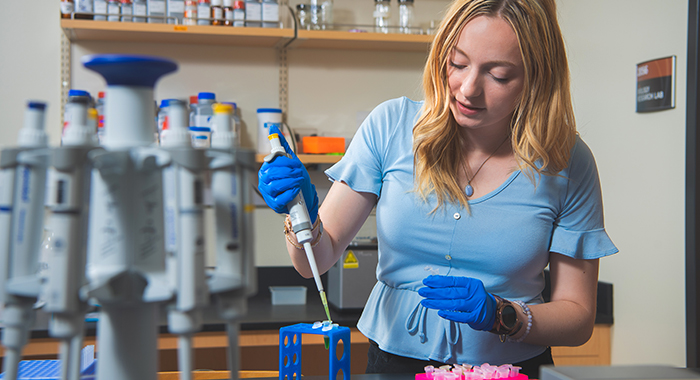A Family’s Search for a Missing Medicinal Root Sends Biology Student Into the Lab
Many families hold cherished traditions and heirlooms and regale any who will listen in tales stranger than fiction, but few can claim a magical medicine cultivated on the ancestral farm for generations. And even fewer have a burgeoning biological scientist within their ranks with the aptitude to uncover the exact species of plant in the recipe, now down to its last batch.
From generation to generation
The great-grandmother of Isabelle Arnold ’25 was tending to patients when a young Native American man came in with his father for burn treatment. He faced a long road to recovery and was believed likely to develop extensive scarring and possibly be in need of cosmetic surgery. The father gave her a topical medicine and requested that she apply it daily to his wounds. She obliged, and after a few days' recovery, the story goes, the son walked out the door with nary a scar. It was as if the burns never occurred.
Amazed by the results, Arnold’s great-grandmother acquired the recipe and base root for the medicine from the patient’s father. She planted the latter around her little farmhouse in Door County, Wis.
“My family has used this medicine for superficial wounds, like cuts and scrapes. They boiled the leaves in water to treat dandruff. The roots for the medicine, we called it blackroot. We chopped the roots, put them in a big pot with melted Vaseline,” says Arnold.
Seven years ago, the family moved – one of many moves – and the root was lost. Now, they’re down to the last batch.
A plan comes into focus
In her second semester at SNC, Arnold went to Ryan King, Adam Brandt and Rachel McCoy (Biology) with an idea. She didn’t know where to start but knew where she wanted to end: with a definitive idea of the exact species used in her family’s homemade topical medicine. Some fine-tuning and narrowing of research methods gave Arnold a clearer focus for a Summer Undergraduate Research Forum (SURF) project, with McCoy advising.
McCoy is in her second year teaching plant biology at SNC. Her focus is plant biochemistry. “I'm interested in the chemicals that plants make to defend themselves and interact with their environments. And a lot of those chemicals end up being medicinal. So, when Isabel approached me with this medicinal plant that we don't know what kind of compound is causing these activities, that was really exciting for me,” McCoy says.
“What I envisioned for this project is that we test how this medicine that’s been in her family for generations works, what kinds of things it’s doing. Is it antimicrobial? Is it causing wound healing? And then also how the plant makes that, and why the plant is doing this, because the plant isn’t making a medicinal compound to help us. It’s doing it to help itself. And we just benefit from that.”
In the lab
The summer was spent focused on using circumstantial evidence to identify the plant used in the medicine. There are a few clues. The family called it blackroot – but blackroot is a common name, not a scientific one, so it spreads across multiple distinct plants. Blackroot is mainly native to the Southwest, so the research pair dug deeper and found a plant native to Wisconsin sometimes referred to as blackroot: the Culver’s root. The root is known to be used for wound healing and was used by the Cherokee, Iroquois, Chippewa and Menomonee nations.
The researchers investigated the regeneration process of the plant and took extracts of the leaf, stem and roots, looking at antimicrobial activity. Arnold says the research showed a lot of promise and, in the process, she learned how medicinal plants work and learned to love the Culver’s root.
“My family used the root, but I was very curious to see if antimicrobial properties come from other places as well,” Arnold says. “And when we tested that, we saw that the leaves had a zone of inhibition on our staph bacteria. … We want to do some more work this semester to see if we can identify that antimicrobial component, which I thought was pretty cool. So basically, the plant is making something that is keeping staph or relative of the staph that we have a lot of trouble keeping from growing. That’s a cool thing.”
But alas, the research led to a conclusion that the Culver’s root was not a match to her family’s missing root.
More to come
Arnold has support behind her to continue her research, both in the lab and back home. Arnold says her relatives thought her research “was extremely cool.”
“Throughout the summer I was posting some pictures on my Facebook as well to show them what I was doing in the lab. At the end my research with SURF, a lot of them said things like, ‘I'd be really interested in your findings.’ ”
She is treating this past summer as just the first phase; a project of this scope would take a full-time researcher roughly two to three years, says McCoy.
Plans are in motion to reach out to Wisconsin Native American nations to see if they have heard of this root. McCoy and Arnold also are exploring using chromatography to identify the ingredients in the medicine. Chromatography is used to separate a mixture of chemicals by their properties.
Arnold and McCoy plan to pursue more testing on the Culver’s root’s exciting antimicrobial properties, and they have a few plants identified to ensure the family medicine helps the next four generations.
Sept. 7, 2023












